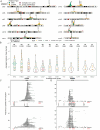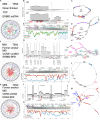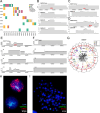Disentangling oncogenic amplicons in esophageal adenocarcinoma
- PMID: 38744814
- PMCID: PMC11094127
- DOI: 10.1038/s41467-024-47619-4
Disentangling oncogenic amplicons in esophageal adenocarcinoma
Erratum in
-
Author Correction: Disentangling oncogenic amplicons in esophageal adenocarcinoma.Nat Commun. 2024 May 28;15(1):4533. doi: 10.1038/s41467-024-48912-y. Nat Commun. 2024. PMID: 38806493 Free PMC article. No abstract available.
Abstract
Esophageal adenocarcinoma is a prominent example of cancer characterized by frequent amplifications in oncogenes. However, the mechanisms leading to amplicons that involve breakage-fusion-bridge cycles and extrachromosomal DNA are poorly understood. Here, we use 710 esophageal adenocarcinoma cases with matched samples and patient-derived organoids to disentangle complex amplicons and their associated mechanisms. Short-read sequencing identifies ERBB2, MYC, MDM2, and HMGA2 as the most frequent oncogenes amplified in extrachromosomal DNAs. We resolve complex extrachromosomal DNA and breakage-fusion-bridge cycles amplicons by integrating of de-novo assemblies and DNA methylation in nine long-read sequenced cases. Complex amplicons shared between precancerous biopsy and late-stage tumor, an enrichment of putative enhancer elements and mobile element insertions are potential drivers of complex amplicons' origin. We find that patient-derived organoids recapitulate extrachromosomal DNA observed in the primary tumors and single-cell DNA sequencing capture extrachromosomal DNA-driven clonal dynamics across passages. Prospectively, long-read and single-cell DNA sequencing technologies can lead to better prediction of clonal evolution in esophageal adenocarcinoma.
© 2024. The Author(s).
Conflict of interest statement
R.C.F is named on patents related to Cytosponge and related assays which have been licensed by the Medical Research Council to Covidien GI Solutions (now Medtronic) and is a co-founder of CYTED Ltd. These are not directly involved in the topic of this paper. R.C.F. has received consulting and/or speaker fees from Medtronic, Roche, and Bristol Myers Squibb. The remaining authors declare no competing interests.
Figures





References
MeSH terms
Grants and funding
LinkOut - more resources
Full Text Sources
Medical
Research Materials
Miscellaneous

